Gallery
-
Vituð ‘ér enn – eða hvað?
The present conflict in Ukraine is once again a reminder of the devastating impact on humanity and the threat of nuclear war. Two works from the artist Rúrí’s archive poignantly address these subjects, statement on how easily progress toward peace can be undone.
Museum (1987) was created in the year that US President Ronald Reagan and the President of the Soviet Union Mikhail Gorbachev signed the Intermediate-Range Nuclear Forces Treaty (INF Treaty), the initial talks for which were held in Reykjavík in October, 1986 . The installation comprises 15 boxes that take their shape from chests commonly found in family homes that might contain objects of sentimental and investment value. As the title suggests, the boxes reference display cases found in museums and archives, into which objects of importance to culture or civilization might be held for safekeeping or put on display for the benefit of celebrating intellectual, creative, or historic achievement.
In Rúrí’s museum, assemblages of items collected over a ten-year span, from places specific in their geographical location and nonspecific in the randomness of their selection, point not to objects of personal, cultural, or historical significance, but rather to the banal and mundane reality of everyday life. Taken together, the displays of precisely arranged things — documents, timepieces, tools — ask us to imagine a moment at some point in the future, the Earth uninhabited by humans, when some other beings might look upon the detritus left behind to decipher who we were.
Elegy (2000) is a single-channel video documenting visit to Kroatia, Bosnia Herzegovina and Serbia in the beginning of 1998. The aftermath of the war or armed conflicts is everywhere when the camera travels through streets and ruined buildings.
Running time; 10 min.
Camera and post production: Rúrí and KVIK Film Productions
Music: Hilmar Örn HilmarssonIn a career spanning more than five decades, Rúrí, one of Iceland’s preeminent artists, has centered her artistic practice on dealing with moral issues of inhumanity and existential threat, in works that confront imperialism, capitalism, social injustice, and environmental destruction. A pioneer of performance art in Iceland, Rúrí has worked in a wide range of mediums, including painting, sculpture, writing, photography, film, multimedia installations and performance art. Her groundbreaking performance Golden Car (1974), was one of the first works in Iceland to engage in political activism. She represented Iceland at the 2003 Venice Biennale with the work Archive-Endangered Waters, an interactive multimedia installation made up of visual and acoustic data on 52 waterfalls that had disappeared or were threatened by the construction of a dam in the Icelandic Highlands. The piece brought her international acclaim.
Curator Pari Stave is the incoming Director of Skaftfell Myndlistarmiðstöð Austurlands | Center for the Visual Arts, in Seyðisfjörður. She was formerly the Senior Manager of the Department of Modern and Contemporary Art at the Metropolitan Museum of Art, New York.
*The exhibition title is a reference to Völuspá an epic poem related to Old Nordic mythology. -
Termining III
Termining III was presented at the performance exhibition Faculty of Action at Färgfabriken – in Stockholm during three days, October 19th to 21st 2018.
The work is simultaneously a performance and an installation. The artists takes out page by page of a large geographical Atlas of the World. The page is transformed via an electronic paper shredder, and then placed in a clear cellophane bag and fitted with a label with exactly the same inscription as the original page in the book. The ‘pages’ were then installed on a wall.
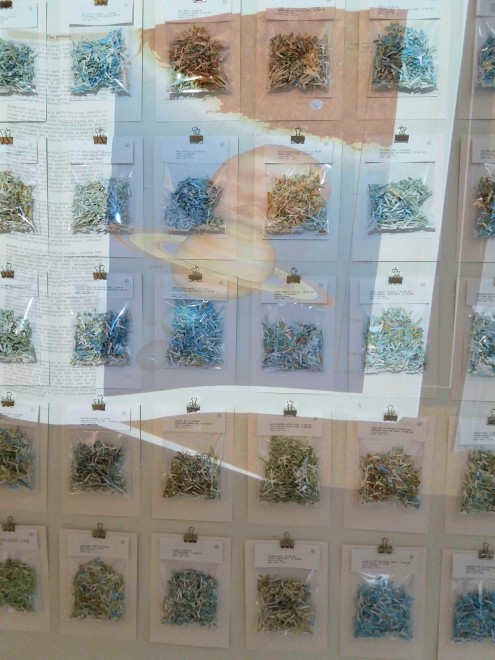


-
Future Cartography VIII, Water Balance II


 The installations Future Cartography VIII, and Water Balance II, were shown at the exhibition Hverfing | Shapeshifting at the Verksmiðjan/Factory in the North of Iceland in 2017.
The installations Future Cartography VIII, and Water Balance II, were shown at the exhibition Hverfing | Shapeshifting at the Verksmiðjan/Factory in the North of Iceland in 2017.Future Cartography VIII involves three maps, each 250 cm in height that the artist has drawn. Each map is a partial maps, and they show the shorelines at the south-east Mediterranean Sea, the east coast of North America, and the south-west coast of Iceland, as these might look if the east shelf of the Antarctic ice shelf melts.
In Water Balance II glass vessels of various sizes and shapes form a procession snaking along the floor. The vessels are partly filled with water. Each vessel represents an individual and the processioncan can be seen as the flight of refugees. Water is the most precious element for life.
Photographs by Pétur Thomsen
-
Flooding – Nature Lost
The video installation Flooding – Nature Lost was first shown in StartArt at the Reykjavik Arts Festival 2008. It has now been installed in larger scale at the Amos Anderson Art Museum in Helsinki.
The artwork consists of two projections and three videos presented on flat screens that are each supported by a wooden structure.
The videos are shot during the filling up of a gigantic man made reservoir in the highlands of Iceland. The videos were shot during the submerging of a waterfall into the reservoir, but they also witnessed a number of birds nests disappearing under the rising waters.



-
Water Vocal – Endangered III
The artwork is a multimedia installation with multiple video projections on large transparent screens, and interactive audio.
The work centres around four waterfalls Dettifoss, Selfoss, Töfrafoss and Urriðafoss. All have been at the focal point of plans for profitable damming opportunities, that have in recent years and months been introduced (to the public) by the power authorities in Iceland. One of these waterfalls, Töfrafoss, recently disappeared under the rising waters of an enormous reservoir.
Water Vocal – Endangered III was completed in 2015. It is composed of six video channels projected on layered screens and multi-channeled audio that is interactive. The spatial environment is reminiscent of an enclosure of high rocks, but simultaneously there is a hint of a labyrinth. The dimensions of the installation are roughly 12 by 12 metres and 4,8metres in height.
The venue is the exhibition ‘Primary Force – Iceland in colour and water’ at the Nordic Watercolour Museum, that is located in the Swedish Arcipelago at Skärhamn, north of Gothenburg.
Images:
top and two images below; installation view the Nordic Watercolour Museum, photo: Kalle SannerBottom four images; stills from the individual videos.
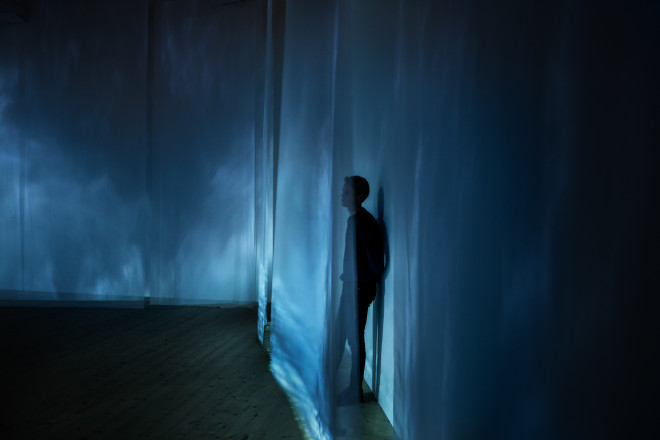





-
Fount – Vocal VII
Fount – Vocal VII by Rúrí is a site-specific performance art piece created specifically for Harpa’s Northern Lights hall and was commissioned by the Reykjavik Arts Festival 2015. Over the last few years, Rúrí has created a series of works exploring the phenomenon of water in its manifold aspects. Widely shown around the world, these works include the performance series Vocal.
The title Fount – Vocal VII refers to the source and foundation of life on Earth and to events of the current moment. At the same time, it also refers to the expression of living beings and phenomena. A large-scale work, it brings together installation, multi-channel video, original music, movement, text, and voices.
The video was produced in collaboration with María Rún, and the sound in collaboration with Bjarki Jóhannsson. The Living Art Museum’s Icelandic Sound Poetry Choir (the Nýló Choir) performed along with the artist.
Duration 30 min.Photographs by Einar Falur; no. 1, 3 and 4, and by Golli; top- photo and no. 2




-
Rainbow I-IV
The new work is based on the original performance and installation Rainbow I (1983).
Rainbow I was made just outside the boarder of Reykjavik. Since that time the city has grown and where the installation was there are now apartment houses.
Archival inkjet print on archival cotton paper, wood.
Dimensions 120 x 174 cm.
-
Vocal VI
Threatened water is the subject of “Vocal-VI”, a video performance created especially for Deep Space in Ars Electronica Center in Linz. A video projection of a large waterfall is on the wall-screen, while on the floor is another projection showing the surface of a manmade reservoir. Words flow over that surface. Words that have been extracted from articles published on the Internet. The texts are written by several authors and offer a critical view on water and the results of mega-damming projects, a view that has often been left out by the public media.
For more information see: Water Globe – Reflections
photographer: Marc Müehlberger
-
Future Cartography III
The tradition of making geographical maps dates back thousands of years. We map regions of the Earth in order to pass on information on the region, for navigation of the region or to study changes in a region, etc. In short, mapping is a method to document spatial /geographical information that we possess. The Future Cartography is based on this long tradition of map making.
Future Cartography III is a study of the future shorelines of the countries of Earth. In the work two landmasses in the region of the Atlantic Ocean were selected as subjects for the study: North America and Iceland. The changes of the shorelines from present time to this future state are based on calculations of the mass of water that will be released during the predicted decline and total melting of the East Antarctic ice sheet.
The calculations are based on information from international datasets. In these maps the zero topological line is set at the present sea level, and other topological lines marked in accordance with that.
The data sets used here are in the public domain and are derivatives of satellite data. In these maps data from the ASTER GDEM Dataset, which is a product of the National Aviation and Space Administration (NASA) and the Japanese Space Authority (METI), are used. In Addition data From the Marine Geoscience Data System is used as well as data from open sources.
Geographical data:
Gunnlaugur M. Einarsson, GeographerInstallation view; Due North, The Ice Box, Philadelphia, 2014



-
Rúrí – Retrospective
On May 6th 2012 was the last day of a large retrospective exhibition; Rúrí – Retrospective, at the National Gallery of Iceland, curated by Christian Schoen.
From Room No. 2: On show, some of the earliest works of the artist from the seventies and early eighties and documentations of these.
Room No. 1 hosted works in the Relativity category (made of centimetre rulers) from the early nineties, as well as conceptual works from the early eighties, made of flat glass.
One part of the exhibition, Room No. 4, will continue as a separate exhibition; Endangered, until the end of December 2012. Endangered features among others the installation Archive – Endangered Waters (2003), and Termining (2008).
Video from Room No. 3: showing an installation of the remains from the performance Dedication (2006) including a video projection.
Video from Room No. 2: some works from the early seventies and eighties and onwards, performance documentations, and an early installation.
More videos coming soon
videos and photos: María Rún Jóhannsdóttir
-
Future Cartography
The artwork Future Cartography is an installation that is exhibited at ASI Art Museum as a part of the (I)ndependent People – Collaborations and Artist Initiatives, Reykjavik Arts Festival 2012.
(I)ndependent People; curator Jonatan Habib Engqvist, project manager Kristín Scheving.Three large scale drawings (height 240 cm) are the main elements of the installation. These are geographical maps which the artist has drawn, exercising the utmost precision. Still they differ from the maps we are used to, they do not show the shorelines of lands and continents the same as we know them to be.
In the preparations to this artwork the artist enjoyed a cooperation with a geographer: The data sets used here are in the public domain and are devariatves of satelite data. In these maps data from the ASTER GDEM Dataset, which is a product of National Aviation and Space Admini- stration (NASA) and Japanese Space Authority (METI) are used together with other information from other datasets.
Gunnlaugur M. EinarssonThe work is a study of the future shoreline of countries. Three countries were selected as samples to focus on; Bangladesh, Egypt and Iceland. The changes of the shoreline from present time to this future state are based on calculations of the mass of water that will be released during the decline and total melting of the East Antarctic ice sheet.
Rúrí
Working in a wide range of media and attempting to express a social and environmental engagement, Rúrí, joins forces with the geographer Gunnlaugur M. Einarsson. A conceptual interest in time and relativity intertwined with a concern for threatened nature and politics here meets the geographers analytical tools in an investigation of future topologies.
Jonatan Habib Engqvistphoto 1 and 4; María Rún Jóhannsdóttir
photo 2 and 3; Pétur Thomsen
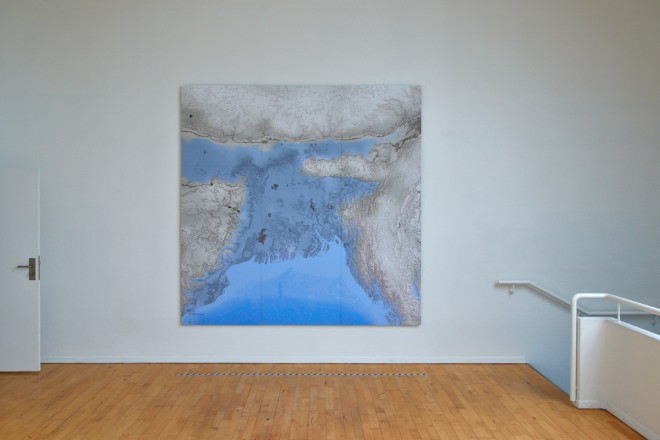

-
Termining
 In 2008 Rúrí took part in an exhibition in Akureyri in the shadow of the economic collapse which took place that year—and which may partly be ascribed to the economic expansion which arose from the Kárahnjúkar hydro-electric plant. She showed Tortími/Termining (both Icelandic and English words are coined by her). The Icelandic title is a punning conflation of tími (time) and tortíming (destruction), with connotations of hard times and destruction. The piece is a mechanical construction which may be seen as symbolizing the way that modern technology shackles nature. Inside the mechanism is a strip of paper seven meters long on which is a picture of Töfrafoss (“Magical Falls”), one of the waterfalls which vanished when land in the uplands was submerged by a reservoir for the Kárahnjúkar hydro plant. When someone approached the piece, sensors activated the machine, the strip of paper rolled downwards into a shredder, and the shredded remains of the waterfall were caught in a transparent plexiglas box. The movements of the mechanism were random, so it was impossible to tell whether the machine would be activated, and how much of the waterfall would be shredded. Hence the observer could not tell what the consequences might be of approaching and looking at the work.
In 2008 Rúrí took part in an exhibition in Akureyri in the shadow of the economic collapse which took place that year—and which may partly be ascribed to the economic expansion which arose from the Kárahnjúkar hydro-electric plant. She showed Tortími/Termining (both Icelandic and English words are coined by her). The Icelandic title is a punning conflation of tími (time) and tortíming (destruction), with connotations of hard times and destruction. The piece is a mechanical construction which may be seen as symbolizing the way that modern technology shackles nature. Inside the mechanism is a strip of paper seven meters long on which is a picture of Töfrafoss (“Magical Falls”), one of the waterfalls which vanished when land in the uplands was submerged by a reservoir for the Kárahnjúkar hydro plant. When someone approached the piece, sensors activated the machine, the strip of paper rolled downwards into a shredder, and the shredded remains of the waterfall were caught in a transparent plexiglas box. The movements of the mechanism were random, so it was impossible to tell whether the machine would be activated, and how much of the waterfall would be shredded. Hence the observer could not tell what the consequences might be of approaching and looking at the work.Gunnar J. Árnason
Reference from TIME by Gunnar J. Árnason, pg 38, the monograph Rúrí, edited by Christian Schoen, published by Hatje Cantz, 2011:
Photographs: Pétur Thomsen
-
Water Globe – Reflections
Water Globe – Endangered Waters
The Earth is one globe, – and all its water circulates around the globe. Water flows from springs, or it trickles as ice-melt from mountain-tops, in small streams that meet other streams down hill and join these and eventually they form rivers, small or large, that flow over long distances until they open into the ocean. In turn the surface water of the oceans evaporates and forms fog or clouds. The clouds float on the winds around the globe, until they give up their vapour in the form of rain or snowfall, some of it feeding icecaps and glaciers.
Since 1998 many of my works are dedicated to water. In many of these I bring the focus onto waterfalls, as they are a mighty expression of the water element. I also choose to work with the water in my immediate surroundings, that is, in the country where I live, Iceland, a country that is surrounded by the ocean. Which ocean, some might ask, but how do we divide the global ocean into several adjoining bodies of water called oceans? Where does one ocean end and another begin, – what could be the boundaries of such vast water bodies?
And that leads to the question; why is man so obsessed with creating boundaries? Why should we create boundaries that crisscross the entire surface of the globe? Names of places like; Provence, Giza, Machu Picchu, Burundi, Ghana, Timor, Germany or Canada, were these names given to separate people? Or were they given to illustrate geographical location of places?
Water cannot be “national” in essence: It is global. The same applies to my works, even though the water is photographed in one country, the essence of the works is global.
The works often bear titles referring to danger, or endangered waters. Some are large-scale video installations with audio, and some are interactive. Others are photographic installations, or video-performances with audio. Vocal VI is the most recent of these.
Vocal refers to the voice of the waterfall – a mighty waterfall has a mighty awe-inspiring voice. But if the water flow dwindles or the water disappears that voice will die.
Rúrí
-
Limpide I Paris & Limpide II Tokyo, Stella Polaris-Paris Photo
top image: Waterfall – Gullfoss II, exhibition view Limpide II, White Cube Gallery, Colette meets Comme des Garçons, Tokyo, 2004, photograph: 181 × 111 × 11.5 cm, audio stand 109 × 20 × 20 cm
image 1-2: visitors reflected in the work Waterfall – Skógafoss, photograph: 181 × 111 × 11.5 cm, exhibition view, Limpide II, 2004
image 3: exhibition view; Central Exhibition-Guests of Honour “Stella Polaris”, Paris Photo—2006, Le Carrousel du Louvre, Paris.
To the right; Waterfall – Skógafossimage 4: Waterfall – Dynkur, Endangered, exhibition view, Central Exhibition- Stella Polaris. Transparent photo positive in twelve parts, 180 × 242 × 8.5 cm, each element: 56 × 56 × 8.5 cm
image 5-6: exhibition view Limpide I, art space at Colette, Paris, 2004
right: Waterfall – Gullfoss I, photograph: 181 × 111 × 11.5 cm, audio stand 109 × 20 × 20 cm -
Rúrí – monograph
The first comprehensive monograph on the artist, with a catalogue raisonné.
Edited by: Christian Schoen
Texts by: Laufey Helgadóttir, Dorothea van der Koelen, Halldór Björn Runólfsson, Christian Schoen and Gunnar J. Árnason
Language: English 208 pages, 296 images, hard coverHatje Cantz (Ostfildern) 2011 ISBN 978-3-7757-2995-6
more informatin / order Hatje Cantz
The book is available at art museums in Reykjavík

Ruri Book pages Desolation

Ruri Book pages Relativity
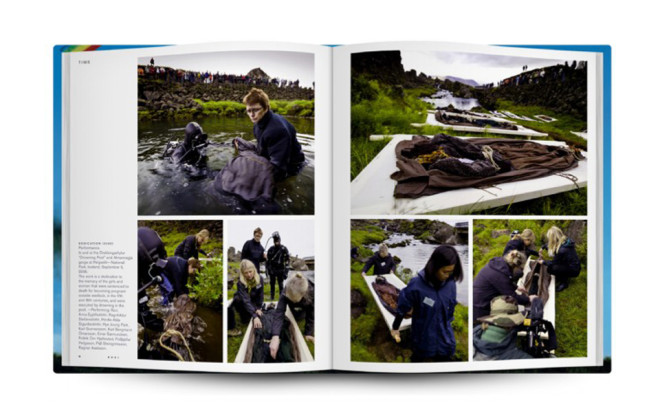
Ruri Book pages_Dedication
-
Reflections
The artist seeks inspiration from Iceland, the country of her origin. The work, a detailed observation of the wonders of our nature, reflects the artist´s perception of nature. It is a reflection on an ever changing landscape, a living nature, the origin of our being.
Each part of the tetralogy focuses on a specific element of nature and the natural forces.
The first part is Water, the fundamental element for all life. The work contemplates the many aspects of the element, in frosen or liquid form.
The second part Moss, is a reflection on the modest but resilient native flora, plants that are found on the tops of windswept mountains, or in the hollows of lava fields, the hardy pioneers that settled where no other plants survived.Reflections, will be completed by the end of 2014. Each element will be screened for several months at a time, 24 hours a day.
The first part Water was inaugurated in 2011 at the opening of the hotel after it being totally renovation. The second part Moss had its premier on the 13th of June 2013.Reflections II,
filming and editing; Maria Rún Jóhannsdóttir, Rúrí
audio; Bjarki Jóhannsson, Rúrí -
The Eyjabakkar Performance
A group of 120 people carried out the Eyjabakkar Performance, with the aim of raising consciousness about the unique natural environment there, which was threatened by a planned hydro plant. The performance was led by Harpa Arnardóttir and Rúrí.
The participants carried and placed on the ground 68 basalt columns; into each piece of basalt one word had been chiseled, from the Icelandic national anthem Ó, Guð vors lands (Oh, God of our Nation), by 19th-century poet Matthías Jochumsson. On the first stone, a short distance from the Eyjabakkavað ford across the Jökulsá river, is the letter Ó. From here the anthem can be read, word by word, along a three-kilometer route (the actual line where the “speculated” dam was planned to stand) to the foothill of the mountain Snæfell, where the last word deyr (dies) is placed.photos: Guðmundur P. Ólafsson, Rúrí



-
Relativity Installations
image 1: Twelve Metres (1991) fiber, lime, wood, 139 × 186 × 4 cm
image 2: Four Metres (1992) lead, wood, iron, brass, 78 x 139 x 5 cm.
image 3: Fifty Metres (1992) lead, wood, iron, brass, 189 × 621 × 5 cm
image 4: Four Square Metres (1992) wooden folding rules, lime, wood, 120 × 510 × 10 cm
image 5: view from the exhibition Relativity at Reykjavik Art Museum, 1992
photo: Sigurgeir Sigurjonssson, Petur Thomsen





-
Vocal IV
This multimedia performance is the most complex hitherto in the Vocal series (Endangered Waters) which Rúrí started in 2005. With a large multi-layered video projection and another smaller one on a side wall of the space, performing artists appeared on the main floor and on the balconies that project into the space on its first floor.
Performed by Rúrí, Jóhann Jóhannsson, conducting and guitar, Matthias Hemstock and Steingrímur Guðmundsson, percussion on Sound Shapes, Pétur Hallgrímsson, Hilmar Jensson and S. Björn Blöndal, guitar and Guðmundur Vignir Karlsson on keyboard. Choir directed by Hörður Bragason.photos: ©2008 Fridrik Orn Hjaltested
VIDEO documentation/Sequences 2008

-
Water Vocal – Endangered
Water Vocal – Endangered is a five channel video installation with interactive audio. The videos are projected onto transparent screens, accompanied with a full audio system. The movements of the viewer inside the installation effects the audio part of the work.
The videos depict several magnificient waterfalls who’s future is in peril, owing to plans to dam up the rivers or tunneling them away from their natural riverbeds. One of the falls depicted has already been destroyed.
measurements: 420 × 1300 × 1300 cm
photos: Fridrik Orn Hjaltested, Rúrí
video: Pall Steingrimsson
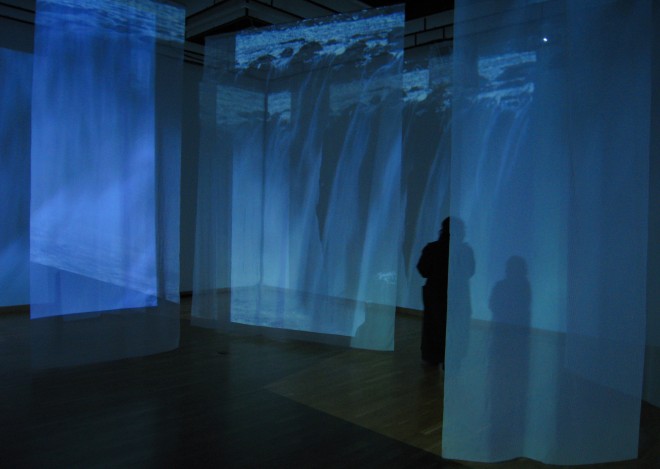
-
Elimination II
Photographs of waterfalls that have disappeared into a vast water reservoir at the Kárahnjúkar dam in the highlands of Iceland, and of others that have been greatly affected by the damming.
photo: Stefan Thor Karlsson
-
Gate – Memorial
Gate is a memorial for missing persons, or persons that have disappeared and never been found, and for those whose remains rest in distant regions of the earth. The gate, which also functions as a lighthouse in the dark, forms a crossroads through a maze that is aligned with the cardinal points.

-
Waterfall
The two columns protrude from a narrow , deep cleft in the ground that is filled with water. Water spurts between the two columns, and also flows over their tops.
A computer controls the flow of water so that it is constantly changing: sometimes the water falls very quietly and sometimes it is like a powerful waterfall.
An interview on the TV station Stöð 2, 1995 (Only in Icelandic)

-
Relativity
top image: Four Metres (1997), fiber
image 1: Three Metres (1997), fiber
image 2: Three Metres (1997), fiber
image 3: Nine Metres – Equilateral Triangle and the
Triangle Ten (1992), wood and brassimage 4: One Cubic Metre (1994), fiber
image 5: Cubic Metre II and III (1996), fiber and basalt
photos: Petur Thomsen, Sigurgeir Sigurjonsson, Gudmundur Ingolfsson

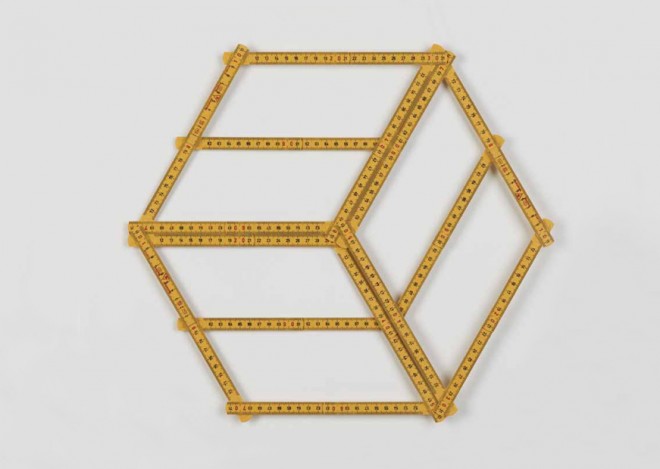



-
Performances II
Identity III
Performance at Henie Onstad Kunstsenter, Oslo, Norway, 1981;
image 1Una performance para duas pessoas – Performance for Two Persons That do not Understand Each Other’s Language
Performed at Stichting de Appel, Amsterdam, in a darkened room, two persons Rúrí and Flavio Pons, silk-blindfold, microphones, audio system, voices; 1978;
image 2Paintings
Installation and performance in six parts. wood, canvas, oil colours, acrylic colours, glass, water, food. Performance at Gallerie Kanal 2, Copenhagen 1979;
image 3


-
Sunlight II
A series of photographs show the process of small plants growing from seeds inside a black box, and then wither away. The process is described in a concise text. A “Sunlight” is fitted on the inside of the lid of the box.
Sunlight II, 1977.
Materials: Wooden box, plants, earth, soap, text, photographs, glass.
Dimensions: 56 × 76.5 × 30 cm.
Sunlight II
-
Performances
Golden Car
Performed by Rúrí, B. Gylfi Snorrason and unknown participants from the audience, ca. 60 min. Lækjartorg, Reykjavík, 1974.
image 1Sculpture
Performance at Gallerí SÚM, Reykjavík, 1975
image 2A Proposition How to Change the Icelandic National Costume to Meet With Modern Icelandic Society
Performed at Háskólabíó, University Cinema, December 1, 1974
image 3
-
Kuopio Observatorium
The public installation translates the differing length of four days of the year in Kuopio into objective form. These days are the spring equinoxes the summer solstice, the autumn equinoxes and the winter solstice.
The work was made for the outdoor exhibition Kuopio Tieno ö Wxperimental Environment, in 1995. The height of the columns is 200 cm.

-
Changing Waters
Multimedia installation
Three-channel video projection and sound. Two projections on screens and a third one directly onto the masonry structure itself.
Curator Serafine Lindemann/ artcircolo www.overtures.de


-
PARADISE? When?
The work evolves around the consequences of armed conflicts in the last decade of the twentieth century. The installation, covering 500 m², consists of a film area with video-films from Bosnia-Herzegovina shown paralel on three different walls, an index card system of persons missing through armed conflicts counting some 100.000 cards, a photographic area, a computer area, silk screens on steel, and more.



-
Rainbow
The sculpture is positioned in front of the International Air Terminal Building (Leif Eirikson Air Terminal) at Keflavík Airport. Installed; 1991.
I like to think of the Rainbow as an unfinished construction, and imagine that maybe one day – after some one hundred or one thousand years or so – someone might decide to continue the work.
The construction would reach higher and higher up into the sky, then decline again … until at last it would become a complete rainbow.
The height of the sculpture is 24 metres. The work is made of stainless steel and stained glass and rises from a low platform of huge tiles of natural stone (basalt).



-
Archive – Endangered Waters
An interactive installation, the work comprises 52 photographs of waterfalls which Rúrí has taken on the banks of both muddy glacial torrents and clear mountain streams. The pictures are developed on transparent film, mounted between two sheets of glass and arranged in sliding slots installed inside a huge steel frame structure, literally forming an archive of sorts. All the photographs are precisely and scientifically labelled and when a photograph is drawn out one can hear the sound of that specific waterfall.
Since 2003 almost half of the waterfalls have been damaged or they do not exist any more. Their destruction is a side effect of one massive damming project, which was carried through in order to feed a new electrical power plant in the pristine highlands of Iceland. This power plant has the sole purpose to provide electricity for one aluminum smelter. The aluminum smelter is run by a company which is owned and operated by global investors.
The Archive – Endangered Waters offers a local example of a global situation.
Water is the most precious element on earth for human life. Still industrialization, both local and global, is the cause of massive polluting of waters. At the same time hundreds of millions of people are suffering from the lack of safe drinking water.Certainly, water will become the blue gold of our future

03 Fra Feneyjum





-
Water Story and Vocal V
The work is made in cooperation with composer Hilmar Orn Hilmarsson, and was performed by Hilmar Orn Hilmarsson; keyboard, Hilmar Orn Agnarsson; church organ, Gerd Kötter; second organ and keyboard, Ruri; vocal, guest artist Markus Zahnhausen; block flute. The video which is projected onto translucent textiles stretching across the nave of the church shows waterfalls and high voltage electronic installations and cables. An important part of the work is that the musicians improvise on the instruments within the frame defined by the composer and the artist.
Duration 40 min. The video is made in cooperation with Fridthjofur Helgason and Páll Steingrímsson; filming, and O. Ragnar Halldorsson; editing exhibition venue: Rúrí – Water Story Vocal V, and Changing Waters installation location: Water Story Vocal – V and Changing Waters by Rúrí, St. Lukaskirche Munich, curator Serafine Lindemann/ artcircolo www.overtures.de, photo: Uta Kellermann, AVISIO picture & concept

-
Dedication
The work is a dedication to the memory of the girls and women that were sentenced to death for becoming pregnant outside wedlock, in the seventeenth and eighteenth century, and were executed by drowning in the pool.
The work was performed at Drekkingarhylur, the Drowning Pool, at Thingvellir in Iceland on September 5th. 2006, in connection with the exhibition Mega Vott.
Performing: Ruri, Anna Eyjolfsdottir, Ragnhildur Stefansdottir, Thordis Alda Sigurdardottir, Hye Joung Park, Karl Gunnarsson, Karl Bergmann Omarsson, Einar Saemundsen, Fridrik Orn Hjaltested, Fridthjofur Helgason, Pall Steingrimsson, Ragnar Axelsson.
Duration of performance 90 minutes.Photographs: Fridrik Orn Hjaltested
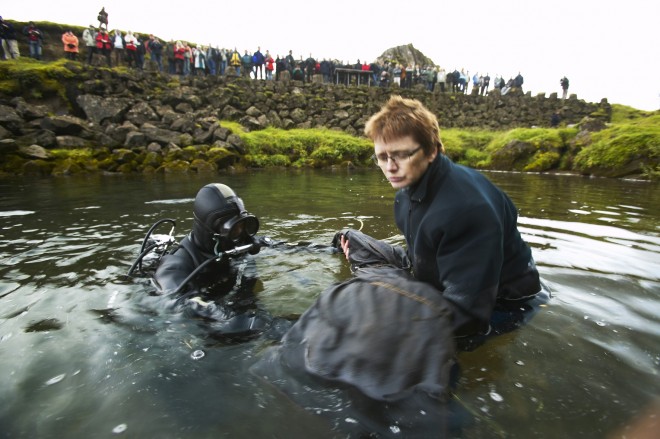
-
Moderation
“The artwork is built around balance. The ten-metre-long piece is attached through a central axis to a steel bracket that is fastened to the cliff wall. When the weather is calm the artwork is in perfect, horizontal balance. However, the faintest breeze disturbs the equilibrium and starts it “rolling” back and forth. As the artwork turns on its axis, its movement is slow and buoyant, owing to a sophisticated mechanism contained within the outer shell. After a time, a weight built into the triangular shape below the axis eventually brings the artwork back into a state of balance.
video: Pall Steingrimsson

Moderation

Moderation
-
Aqua Silence
The work touches the many aspects of water – The images are powerful and poetic, as is nature; ocean waves, waterfalls and glaciers are brought into Munich. Aqua – Silence offers a layered comprehension; the visual level involving form and colour and the shifting of these – the emotional – the intellectual and conceptual – time and timelessness …
The screens are located where Munich litterally meets the rural surrounding, a popular recreational area, with the river Isar flowing only a couple of hundred meters away. Meanwhile the automobile traffic towards the city centre flows constantly alongside the installation. This is where urban and rural meet, and simultaneously the nature and technology meet in the artwork, the high tech LED screens and sophisticated software meet the primal force and beauty of water in its many appearances, from droplets to glaciers.
The installation is the seventh of its kind to be presented at the SEVEN SCREENS – Osram Art Projects, since these were created in 2006. The seven steles with a height of six meters each and equipped with LED systems on both sides are based on the green between the OSRAM headquarters and the Mittlerer Ring in the south of Munich.
inauguration and first screening; April – November 2009.see here: VIDEO clip by Frank Sauer from the INAUGURATION of the work at OSRAM


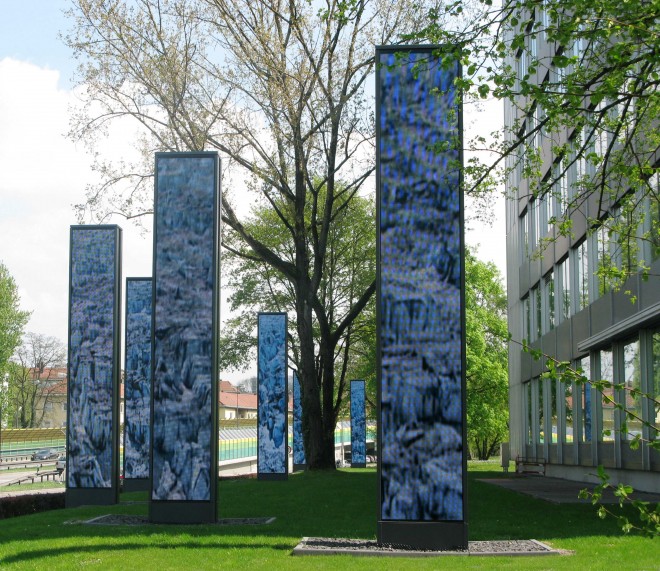
-
Terra Vivax
Contradicting elements, such as creation versus destruction, or the latent power of the volcano while asleep versus the tremendous power that the earth expresses through an eruption, these bring to the surface how precarious is the existence of the human being. The word – precarious – may even illustrate the existence of the Earth in the Universe.
The volcano, – the possibility of an eruption. The relevance between geological-time and human-time concepts. Everything that exists does so in a wonderful balance between stability and tension.The work is made of basalt, that has once flown as lava from the volcano Vesuvius. The sphere rests in balance, but in spite of its massive weight (nine tons) it is easily disturbed. A single person, can send it gently rocking. On the stone under the sphere are engraved the names of all the volcanoes of the earth that have erupted in historic time.
-
Water / Waterfalls diverse works
top image: Endangered Waters, 2006, digital print on glass 200 × 150 × 0.5 cm (variable), Liget Galeria, Budapest, Hungary
image 1 and 2: Dedication – to Sigríður of Brattholt, 2002, series of nine photographs on paper, mounted on acrylic glass. 350 × 350 × 4 cm, 110 × 110 × 4 cm each, Technical College of Hafnarfjörður, Iceland
image 3: A view form the exhibition Clarities, Gerðarsafn – Kópavogur Art Museum, Reykjavík, Iceland 2006
iamge 4, top left: Waterfall, 2004, transparent photo positive in acrylic glass casing 41 × 41 × 8 cm
iamge 4, bottom left: Waterfall, 2004, transparent photo positive in acrylic glass casing 41 × 41 × 8 cm
iamge 4, right: Waterfall – Skógarfoss, 2004, transparent photo positive, acrylic glass casing. Audio, CD-player, CD, headset, stainless steel. Photograph: 181 × 111 × 11.5 cm, audio stand 109 × 20 × 20 cmimage 5: That Day . . . , 2001, photographs, digital prints, glass, wood, cardboard, 130 × 431.5 × 4 cm.
Venue: CEAC-Chinese European Art Center, Xiamen, Chinaimage 6: Passage of Time III, 2000, series of twelve digital prints, based on old postcards, acrylic glass, iron, 190 × 184 × 2 cm.
Venue: Passage of Time II, Galleria Becker, Jyveskyla, Finland
-
Living Art Museum, solo exhibition
Top image: View from a solo exhibition at the Living Art Museum, 1982
Image 1: Peace – (Handle With Care) (1981), engraving in diffusion glass, and in white opaque glass, iron. 40 × 50 × 8 cm
Image 2: Items (IV) (1981), engraved glass, steel. 150 × 120 × 2 cm
Image 3: Relativity (1982), engraving in glass, iron, steel. ca. 80 × 100 × 40 cm



-
Forest
The material is various paper for instance magazines pages, tissue strips, commercial label strips, paper cups, etc. and one thin sheet of paper forms a screen for a rear-projection of a image from a forest.

-
Desolation
Desolation was created in the context of “Flying Concrete— Experimental Environment” 1984 / “Flyvende Betong— Experimental Environment” on the square Kultorvet in Copenhagen.
Flying Concrete was one of the early projects of the Experimental Environment movement, and was an experiment in transporting the Land Art notion into a city. The project was a temporoary exhibition standing for a whole year. All the installations were were taken down in 1985.
The installation is cast in concrete.
Measurements: 400 x 1100 x 1000 cm.
Location: Kultorvet, Copenhagen.

-
WATERFALL I-IX
Photographs on paper (analog photography). The nine waterfalls are also depicted in the installation Archive-Endangered Waters (2003).
-
Elegy
A video work based on a visit to Kroatia, Bosnia Herzegovina and Serbia in the beginning of 1998. The aftermath of the war or armed conflicts is everywhere when the camera travels through streets and ruined buildings.
Running time; 10 min.
Camera and post production: KVIK Film Productions
Music: Hilmar Orn Hilmarssonlocation; Hafnarborg Art Centre, Iceland
photo; Stefan Thor Karlsson -
Rainbow I
The rainbow materializes out of the blue, lasts for a few moments and disappears as suddenly as it appeared. Nobody can grasp it, nor even get close to it, yet it holds a very special value for most people.
Height of installation 1700 cm,
duration of performance 20 min.
Korpúlfsstaðir, Reykjavík, August 25, 1983.The work, in the form of an installation and a performance was filmed, and exists in the form of a video-work.

-
Glassrain
The installation was made in 1984, it consists of 500 pieces of glass that are suspended from the ceiling, each one has razor sharp edges.
A narrow V-formed pathway, snakes through the installation. Although not obviously so the passage is free of suspended glass-fragmens. When entering the passage one can not detect whether the pathway continues or comes to an end in the center of the installation, so it appears that one might need to back out the same way one entered. It is not until one reaches a bend of the pathway that the second entrance/exit becomes visible.Individual glass pieces vary in length from 50 to 150 cm.
The passage is approximately 70 cm wide.
Measurements of installation; 700 x 600 x 400 cm.Exhibition venues: Rúrí, The Reykjavik Art Museum – Kjarvalsstadir 1984 / Rúrí – Glerregn, The National Gallery of Iceland 2001 / RETHINK Kakotopia / RETHINK – Contemporary Art & Climate Change, 2009, which was a part of the official cultural programme in connection with the UN Global Climate Summit, COP 15, which took place in Copenhagen from December 7 to 18 2009.

-
Flooding
Flooding is a video installation with two synchronized projections and audio. The work was created for the Ars Electronica 2007 in Linz.
The installation is based on the waterfall Toefrafoss, and a surrounding oases of lush vegetation which at the time of the exhibition was disappearing under the rising waters of an enormous reservoir that has been created by building a colossal dam in the highlands of Iceland. The dam was made for a hydro electrical power plant, built to power an aluminum smelter.
In this work Rúrí documents using video and audio, and presents in an installation how industrial interests are bringing about the flooding of an unique highland ecosystem in her country and causing its unalterable destruction. Even though the artist focuses the camera on waterfalls in her own country, Iceland, the Endangered Waters works are simultaneously local and global in concept. (Serafine Lindemann)
The work is made with the cooperation of Kvik Film Productions and cameraman Fridthjofur Helgason.
photo: Mila Pavan
-
ENDANGERED WATERS – TOFRAFOSS II
The multimedia performance Endangered Waters – Tofrafoss II is dedicated to the waterfall Tofrafoss that was in the process of disappearing into a huge water reservoir for a new power plant in the highlands of Iceland at the time.
The work involves a layered video projection, audio and voice. The performance took place in Gallery Art On Armitage in Chicago in conjunction with the exhibition Endangered Waters in August 2007.
photo: Mary Ellen Croteau
-
Woman / Freedom
The work Woman / Freedom (1973) reflects on the contemporary social debate in Iceland at the time of its creation.
Found objects, the original work got lost and was reconstructed in 2011.
Barbie doll, iron, bronze paint
43 × 33 × 33 cm




























